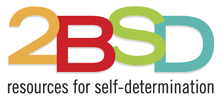- Posted on
- By Sharon
- In 2BSD Blog, Teaching & Learning
- Leave a comment
We are pleased to present the results of a study conducted by Dr. Yi-Fan Li, Assistant Professor, University of Texas at San Antonio. Dr Li was one of our 2019 minigrant recipients when she was completing her doctorate at Texas A & M University. We are proud to have made a contribution to her work to help students with disabilities in college settings exercise increased self-determination by advocating for the use of Universal Design for Learning. We asked Dr. Li to write a summary of her findings to share with you.
2BSD 2019 Mini-Grant Brief Report
By Yi-Fan Li, Ph.D.

Dr. Yi-Fan Li
Assistant Professor, University of Texas at San Antonio
My name is Yi-Fan Li, and I am an Assistant Professor at The University of Texas at San Antonio. I received a mini grant from 2BSD to complete work on my dissertation. I am very grateful for the opportunity which helped me to achieve my career goals.
As an individual with a hearing impairment, it has been important for me to make requests for accommodations. But asking for such accommodations has not been easy. So in my doctoral studies, I decided to research an inclusive teaching framework, the Universal Design for Learning (UDL).
Compared to students without disabilities, students with disabilities could experience more challenges in post-secondary education. UDL provides flexibility in classrooms. By applying UDL principles, instructors can effectively address learning needs of diverse learners in class. My dissertation title is Universal Design for Learning in Postsecondary Education: Measure and Explore Perspectives of Students with Disabilities. This is a three-article dissertation. In the first article, I reviewed the studies regarding faculty attitudes and actions toward UDL practices. In the second article, I investigated the perceptions and attitudes of students with disabilities regarding UDL. The third article served as a follow-up to the second article. In accordance with the responses from the online survey, I invited students with disabilities to participate in a focus group to discuss their experiences with UDL in the classroom. In the second and third articles, I demonstrated the five elements of self-determination to participants by using the action model for self-determination (2BSD, 2019; see Figure 1 below). Participants learned how to advocate for themselves if they planned to communicate UDL practices with their instructors.
By completing this project, I was able to embrace all aspects of my identity as a researcher, as a teacher, and as an individual with a disability. I improved my ability to communicate and collaborate as I worked with disability services and fellow doctoral students. Part of achieving self-determination is learning to ask for help, and I was able to ask for the resources and support that I needed to complete my dissertation.
Currently, I am working with my colleagues at UTSA to develop a UDL course in our teacher preparation program. In this course, students learn culturally responsive/sustaining pedagogy, social-emotional learning, trauma-informed pedagogy, and restorative justice practices through UDL. The mini-grant I received from 2BSD paved the way for my future career goals and gave me an opportunity to improve my self-determination.
Figure 1 Steps to communicate UDL practices with instructors through the Action Model of Self-determination.


No comment yet, add your voice below!